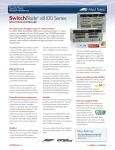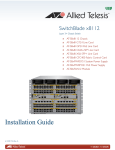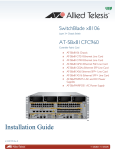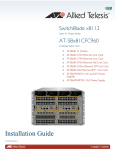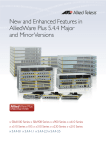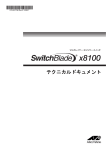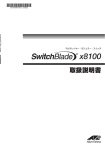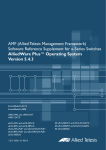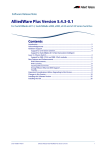Download Allied Telesis x3100 Series System information
Transcript
Technical Guide SwitchBlade x8100 Series System Overview ® Next Generation Intelligent Layer 3+ Chassis Switches SwitchBlade x8100 Series | System Overview Contents Introduction..................................................................................................................................................................................3 SwitchBlade x8100 Series – Chassis...........................................................................................................................4 SwitchBlade x8100 Series – Chassis...........................................................................................................................5 SwitchBlade x8100 Series – Control and Line Cards...................................................................................6 CFC400 Control Card............................................................................................................................................6 CFC960 Control Card.............................................................................................................................................7 SwitchBlade x8100 Series – Power Supplies and Cooling........................................................................8 System PSUs....................................................................................................................................................................8 PoE PSUs............................................................................................................................................................................8 System cooling................................................................................................................................................................9 SwitchBlade x8100 Series – Internal Architecture..........................................................................................10 Data plane connectivity...........................................................................................................................................10 Data plane load balancing......................................................................................................................................11 Data plane traffic management.........................................................................................................................11 Control plane connectivity...................................................................................................................................12 Control card synchronization.............................................................................................................................13 CPU traffic prioritization and rate limiting................................................................................................14 SwitchBlade x8100 Series – Switch Startup.........................................................................................................15 Switch startup operation.......................................................................................................................................15 Managing the chassis..................................................................................................................................................15 Chassis reboot................................................................................................................................................................15 CFC fast failover .........................................................................................................................................................15 Hot-swapping CFCs...................................................................................................................................................15 Hot-swapping line cards..........................................................................................................................................15 Software upgrading....................................................................................................................................................16 Incompatible software releases.........................................................................................................................16 CFC disabled master ...............................................................................................................................................16 System information.....................................................................................................................................................17 Appendix A: SwitchBlade x8100 Series Network Solutions .......................................19 Solution 1 – SwitchBlade x8100 (CFC400) network core resiliency...................................20 Solution 2 – SwitchBlade x8100 (CFC400) distributed network with EPSRing.........21 Solution 3 – SwitchBlade x8100 (CFC960) complete network core resilience..........22 Solution 4 – SwitchBlade x8100 (CFC960) distributed collapsed backbone................23 Solution 5 – SwitchBlade x8100 Series as AMF master.................................................................24 2 | SwitchBlade x8100 Series System Overview alliedtelesis.com SwitchBlade x8100 Series | System Overview Introduction The SwitchBlade x8100 Series next generation intelligent Layer 3+ chassis switches are designed to deliver high availability, wire-speed performance, and a high port count. Allied Telesis advanced features make them the ideal solution for the modern enterprise network where resiliency, reliability and high performance are the key requirements. The SwitchBlade x8100 is available in 6-slot and 12-slot models, with an extensive range of connectivity options. Dual control cards are partnered with the line card slots. Gigabit and 10 Gigabit line card options ensure a system capable of meeting the requirements of today’s networks, and the flexibility to expand when required. Two control card options, the CFC400 and CFC960, are available, which allow the SwitchBlade x8100 Series to be deployed in medium to large scale networks. The CFC960 is a more powerful control card to support larger networks, and can double the backplane bandwidth of the chassis. It also supports advanced features like VCStack Plus and VRF-Lite. VCStack Plus allows two chassis to be stacked together into a single virtual unit. This creates a powerful and completely resilient network core, which can even be distributed over long distance The SwitchBlade x8100 Series, along with other Allied Telesis SwitchBlade and X Series switches, runs the AlliedWare Plus operating system, providing an industry standard CLI and a comprehensive feature-set. As an alternative to the CLI, a GUI (Graphical User Interface) allows for web based monitoring and configuration of the SwitchBlade x8100 Series.* This document provides an overview of the SwitchBlade x8100 Series hardware, internal architecture and switch operation. Appendix A highlights two CFC400 based network scenarios and two CFC960 based network scenarios where the SwitchBlade x8100 Series can provide powerful solutions. A 5th scenario shows how the SwitchBlade x8100 Series can be the center of an Allied Telesis Management Framework (AMF) network. AMF automates many everyday network administration tasks. The complete network can be managed as a single virtual device with powerful centralized management features. Growing the network can be accomplished with plug-and-play simplicity, and network node recovery is fully zero-touch. *The GUI for a CFC960 based system will be available Q2 2014 SwitchBlade x8100 Series System Overview | 3 SwitchBlade x8100 Series | System Overview SwitchBlade x8100 Series – Chassis The SwitchBlade x8112 is a 7 rack unit modular chassis comprising: ■■ 2 Controller Fabric Card (CFC) slots ■■ 10 Line card slots ■■ 2 System PSU bays ■■ 2 PoE PSU bays ■■ Fan tray A number of components have specific positions in the chassis: ■■ System PSUs use the 2 right hand bays ■■ PoE PSUs use the 2 left hand bays ■■ CFCs use slots 5 & 6 ■■ Line cards use slots 1-4, 7-12 All of the above system components are hot-swappable to maximise system uptime during maintenance or reconfiguration. PoE PSU bays System PSU bays 10 x Line card slots 7RU 2 x Control Fabric card slots Fan-tray bay The rear of the chassis provides power cord receptacles for the system and PoE power supplies. The backplane of the SwitchBlade x8112 is completely passive for high reliability, and is maintenance free. There are 3 extra small covers on the rear of the chassis for easy access to system components. The left-hand cover provides access to the chassis ID EPROM, and the right-hand covers provide access to the opto-couplers, used for PSU isolation. System power cord receptacles Chassis ID EPROM cover 4 | SwitchBlade x8100 Series System Overview PoE power cord receptacles PSU opto-coupler covers alliedtelesis.com SwitchBlade x8100 Series | System Overview SwitchBlade x8100 Series – Chassis The SwitchBlade x8106 is a 4 rack unit modular chassis comprising: ■■ 2 Controller Fabric Card (CFC) slots ■■ 4 Line card slots »» A 5th Line card can replace one CFC ■■ 2 System PSU bays ■■ 2 PoE PSU bays ■■ Fan tray A number of components have specific positions in the chassis: ■■ System PSUs use the 2 right hand bays ■■ PoE PSUs use the 2 left hand bays ■■ Line cards use slots 1-4 ■■ A CFC uses slots 5 ■■ A CFC or Line card uses slots 6 All of the above system components are hot-swappable to maximise system uptime during maintenance or reconfiguration. PoE PSU bays System PSU bays 4 x Line card slots 4RU Fan-tray bay 1 x Control Fabric card slot 1 x Control Fabric or Line card slot The rear of the chassis provides power cord receptacles for the system and PoE power supplies. The backplane of the SwitchBlade x8106 is completely passive for high reliability, and is maintenance free. There are 3 extra small covers on the rear of the chassis for easy access to system components. The left-hand cover provides access to the chassis ID EPROM, and the right-hand covers provide access to the opto-couplers, used for PSU isolation. System power cord receptacles Chassis ID EPROM cover PoE power cord receptacles PSU opto-coupler covers SwitchBlade x8100 Series System Overview | 5 SwitchBlade x8100 Series | System Overview SwitchBlade x8100 Series – Control and Line Cards ■■ SBx81CFC960 (Controller Fabric Card) ■■ SBx81CFC400 (Controller Fabric Card) ■■ SBx81GT24 (24 x 10/100/1000T Line Card) ■■ SBx81GT40 (40 x 10/100/1000T RJ.5 Line Card) ■■ SBx81GP24 (24 x 10/100/1000T PoE+ Line Card) ■■ SBx81GS24a (24 x 100/1000 SFP Line Card) ■■ SBx81XS6 (6 x 10Gbps (SFP+) Line Card) Note: The SwitchBlade x8100 Series shares hardware design with the Layer-2 SwitchBlade x3100 Series chassis. To ensure no possible conflicts if an incorrect card is installed - if a SwitchBlade x3100 line card is put into a SwitchBlade x8100 chassis it will not power up, and is held in reset. With 10 line card slots available, the SwitchBlade x8112 supports: ■■ 400 GbE copper ports ■■ 240 GbE copper ports with PoE+ ■■ 240 GbE fiber ports (SFP) ■■ 60 10GbE ports (SFP+) ■■ or any combination When using 5 line card slots, the SwitchBlade x8106 supports: ■■ 200 GbE copper ports ■■ 120 GbE copper ports with PoE+ ■■ 120 GbE fiber ports (SFP) ■■ 30 10GbE ports (SFP+) ■■ or any combination CFC400 Control Card As shown above the CFC400 control card includes a standard RS-232 asynchronous port, and an Ethernet port for out of band management. It also includes a USB connector, allowing the easy transfer of files and additional storage as required (the USB connector supports USB storage devices only). Centralised LEDs provide status of all 12 card slots, along with CFC, PSU and fan tray. In keeping with our commitment to environmentally friendly processes and products, the SwitchBlade x8100 Series is designed to reduce power consumption and minimize hazardous waste. Features include the use of high efficiency 6 | SwitchBlade x8100 Series System Overview power supplies and low power chip sets. The CFC400 also include an ECO-Switch button on the front panel allowing conservation of additional power by turning off all diagnostic LED indicators across the chassis when they are not required. The name CFC400 is derived from the fact that these control cards will provide 40 gigabits bandwidth per line card slot (x 10 slots = 400Gbps). With two CFC400 control cards installed, the system will provide 800Gbps system bandwidth. alliedtelesis.com SwitchBlade x8100 Series | System Overview CFC960 Control Card The CFC960 shown above provides all of the same connectors and front panel information as the CFC400 shown previously, plus 4 x 10GbE SFP+ ports. The SFP+ ports can be used for standard 10GbE connectivity (fiber only) or for stacking two SwitchBlade x8100 Series chassis together into a single virtual unit using VCStack Plus. As the stacking connectors are fiber the two chassis do not need to be collocated, but can be kilometres apart – perfect for a distributed core environment, or datamirroring solution (as shown in Appendix A). The name CFC960 is derived from the fact that these control cards can provide up to 80Gbps bandwidth per line card slot. 80Gbps x 10 line card slots (SBx8112) 4 SFP+ front panel ports Inter CFC link Total = 800Gbps = 80Gbps = 80Gbps = 960Gbps (CFC960) Having two CFC960 control cards installed in a SwitchBlade x8112 provides 1.92Tbps switching fabric. SwitchBlade x8100 Series System Overview | 7 SwitchBlade x8100 Series | System Overview SwitchBlade x8100 Series – Power Supplies and Cooling The SwitchBlade x8100 Series includes AC and DC system power supply options. Optional PoE power supplies will supply power to endpoints when used with the SBx81GP24 line card. The power supplies and fan tray available are: ■■ SBxPWRSYS1 (1200W AC System Power Supply) ■■ SBxPWRSYS1-80 (1200W DC System Power Supply) ■■ SBxPWRPOE1 (1200W AC PoE Power Supply) ■■ SBxFAN12 (Fan tray for 12 slot chassis) ■■ SBxFAN06 (Fan tray for 6 slot chassis) The two system and two PoE power supplies have individual power cord receptacles on the rear of the chassis, so each can be fed from separate power sources if desired to further increase reliability and resiliency. For specific power outlet requirements (dependent on voltage in your country) see the installation guide. PoE PSUs A PoE power supply (SBxPWRPOE1) will fit into the system PSU bay, but they are electronically keyed so it will not power up and the chassis won’t boot. Correct PSU placement must be observed for the system to function correctly. The SwitchBlade x8100 Series supports PoE+, which supplies the higher power required from a new generation of network attached devices. These new devices, such as pan tilt and zoom IP security cameras, touch screen displays and so on, frequently require more than the 12.95W available with standard PoE (IEEE 802.3af). PoE+ (IEEE 802.3at) can provide up to 30W of power, with a powered device able to draw up to 25.5W. System PSUs As with other Allied Telesis advanced switches using modular power supplies, one PSU is enough to power the complete SwitchBlade x8100 system. A second power supply will loadshare and provide redundancy. PSUs and the fan tray are all hotswappable so no downtime is encountered during maintenance. The SwitchBlade x8100 Series supports one or two 1200W PoE PSUs, so 2400W maximum. This allows power to be supplied to 80 devices (at the maximum PoE+ specification of 30W) or 155 devices (at the maximum PoE specification of 15.4W). For devices like IP phones which require less power (class 2 PoE of around 7W) then a larger number can be supported. The SwitchBlade x8100 will quite likely be connected to a number of different PoE devices, such as IP phones, security cameras and so on, with each type of device requiring different power levels. Power budgeting manages the allocation of power to the devices connected to SBx81GP24 PoE line cards. This ensures the most efficient use of the 2400W available, and support for the maximum number of PoE devices. As with other AlliedWare Plus switches that support PoE, priority can be set for specific ports (low, high, and critical). This ensures that important devices continue to receive power even if the total power budget is exceeded, with power delivered first to critical, then high, and then low priority devices. Power capacity for a port can be set to anything from 4W to 30W, and PoE can also be disabled for a port if desired. System and PoE power cord receptacles 8 | SwitchBlade x8100 Series System Overview More information on PoE and its operation can be found in the SwitchBlade x8100 Series software reference manual. alliedtelesis.com SwitchBlade x8100 Series | System Overview System cooling Cooling of the SwitchBlade x8100 Series is: ■■ Front to back for the PSUs via their own internal fans ■■ Side to side for the chassis cards via the SBxFAN12 fan tray (which comprises 4 individual fans) for the SwitchBlade x8112. Similarly the SBxFAN06 comprises 2 individual fans for the SwitchBlade x8106, to draw air through the chassis The PSU and control/line card sections of the chassis are physically separated to avoid swirling airflow in the multi-direction system. PSU front-to-back airflow PSU and System airflow are physically separated System left-to-right side airflow Fan-tray bay Any control/line card slot that is unoccupied should have a blanking plate installed to assist airflow through the system and ensure adequate cooling. SwitchBlade x8100 Series System Overview | 9 SwitchBlade x8100 Series | System Overview SwitchBlade x8100 Series – Internal Architecture Data plane connectivity To avoid any single point of failure, the data plane employs a dual star topology. Two 10Gbps data lanes, one from each packet processor on the SBx81CFC400 control card, connect to each line card slot. This provides each line card slot with 20Gbps full duplex per control card, or 40Gbps full duplex per line card slot when two CFCs are installed (x2 = 80Gbps bandwidth per line card slot in both directions), as shown below: The backplane of the SwitchBlade x8100 Series chassis is completely passive, providing high reliability. There are two main interfaces between the control and line cards – the data plane and the control plane. The data plane switching fabric is comprised of packet processors on the control and line cards, which are interconnected via the backplane for data traffic through the chassis. The control plane uses switch chips on the CFC and line cards which are separate from the data plane switching fabric, and is used for internal chassis related communication such as switch management, transferring software releases and so on. The SBx81CFC960 control cards provide the same backplane bandwidth with current line cards. When partnered with the new SBx81XS16 line card (due Q2 2014), the SBx81CFC960 will be able to provide double the backplane bandwidth. Linecard Slot 1 Linecard Slot 2 Linecard Slot 3 Linecard Slot 4 Linecard Slot 7 Packet Processor Packet Processor Packet Processor Packet Processor Packet Processor 10Gbps Links Control Card Slot 5 Packet Processor A Packet Processor B Packet Processor A Packet Processor B Control Card Slot 6 4 x 10Gbps Links = 40Gbps Full Duplex x 2 = 80Gbps/Linecard Slot Packet Processor Packet Processor Packet Processor Packet Processor Packet Processor Linecard Slot 8 Linecard Slot 9 Linecard Slot 10 Linecard Slot 11 Linecard Slot 12 This diagram shows the data plane connectivity for the SwitchBlade x8112 12 slot chasis. The SwitchBlade x8106 6 slot chassis has the same connectivity, but to only 4 line card slots, or can be used with a single control card and 5 line cards with half the backplane bandwidth. 10 | SwitchBlade x8100 Series System Overview alliedtelesis.com SwitchBlade x8100 Series | System Overview A SwitchBlade x8100 Series with two CFC400s or two CFC960s installed provides 80Gbps bandwidth per line card slot*. This provides current line cards with the following performance characteristics: ■■ SBx81GT24 (24 x 10/100/1000T Line Card) non-blocking non-blocking ■■ SBx81GP24 (24 x 10/100/1000T PoE+ Line Card) non-blocking ■■ SBx81GS24a (24 x 100/1000 SFP Line Card)non-blocking ■■ SBx81XS6 (6 x 10Gbps (SFP+) Line Card)3:2 blocking ■■ SBx81GT40 (40 10/100/1000T RJ.5 Line Card) Data plane load balancing To load balance the traffic across the SwitchBlade x8100 Series backplane, a hashing algorithm is used, so that traffic entering the line card from different individual hosts will utilise different data lanes across the backplane. There will either be two or four data lanes available between the line card and control cards, depending on whether one or two control cards are installed in the chassis. These data lanes are treated as a single virtual port (link aggregation group) and so data is hashed down one of the members of the aggregation group. By default this is dependent on the source and destination MAC addresses, and source and destination IP addresses. This spreads the data traffic across the backplane and provides a high performance load-balanced system. Data plane traffic management The SwitchBlade x8100 Series chassis uses a distributed switching architecture, with packet processors on each individual line card. Traffic on the data plane is managed by a combination of synchronized hardware tables, and the fact that the system uses an internal network for forwarding packets as appropriate between the packet processors. Hardware tables are synchronized on all installed CFC and line cards, so the same forwarding/routing information is available locally for lookup on ingress of external traffic. Packets that are destined to egress on a different line card are forwarded across the backplane and on to the appropriate card. *The SBx81CFC960 will be able to provide double the backplane bandwidth when partnered with the SBx81XS16 line card (due Q2 2014) SwitchBlade x8100 Series System Overview | 11 SwitchBlade x8100 Series | System Overview Control plane connectivity The SwitchBlade x8100 Series control plane is facilitated by gigabit switch chips fitted to both the CFC and line cards. These provide a gigabit connection between the CFCs, and from each CFC to each of the line card slots, as shown below: Linecard Slot 1 Linecard Slot 2 Linecard Slot 3 Linecard Slot 4 Linecard Slot 7 Packet Processor Packet Processor Packet Processor Packet Processor Packet Processor Control Plane Switch Chip Control Plane Switch Chip Control Plane Switch Chip Control Plane Switch Chip Control Plane Switch Chip 1 Gbps Links Control Packet Card Processor A Slot 5 Packet Processor B Control Plane Switch Chip Control Plane Switch Chip Packet Processor A Control Packet Card Processor B Slot 6 Control Plane Switch Chip Control Plane Switch Chip Control Plane Switch Chip Control Plane Switch Chip Control Plane Switch Chip Packet Processor Packet Processor Packet Processor Packet Processor Packet Processor Linecard Slot 8 Linecard Slot 9 Linecard Slot 10 Linecard Slot 11 Linecard Slot 12 This diagram shows the control plane connectivity for the SwitchBlade x8112 12 slot chassis. The SwotchBlade x8106 6 slot chassis has the same connectivity, but to only 4 line card slots. 12 | SwitchBlade x8100 Series System Overview alliedtelesis.com SwitchBlade x8100 Series | System Overview Control plane data is managed by the CPU, as it consists of chassis related communication such as switch management, file transfer and so on. To facilitate this, the CPU is connected to the control plane switch chip with a 1Gbps link. It is also connected to each packet processor via 2Gbps PCI Express to manage data traffic that needs to be processed by the switch, for example protocol management packets (STP, EPSR etc). 1 Gbps links Line Card Slot 1 Packet Processor CPU 2 Gbps 1 Gbps link 10 Gbps link Control Card Slot 5 Packet Processor A Packet Processor B CPU 2 Gbps Control Plane Switch Chip Control Plane Switch Chip 1 Gbps links There is, of course, interconnection with other aspects of the cards not shown, such as SDRAM, Flash memory, USB slot, PHYs etc. Control card synchronization When two CFCs are installed in the SwitchBlade x8100, they provide an active/active switching architecture. The packet processors on both CFCs are fully utilised to double the available backplane bandwidth from 40 to 80Gbps per line-card slot. One of the CFCs will become the active chassis master. In normal operation this will be the CFC on the left-hand side (slot 5). The active chassis master manages the system, and processes CPU bound network traffic. The standby CFC runs all network protocol modules and is kept in sync with the active CFC, so is available in ‘hot-standby’ for near hitless failover if required. The network information tables that are synchronized between the two CFCs are shown below. Tables synchronized between the two CFCs FDB ARP Table IP route DB RIP route DB OSPF Neighbor/Route DB VRRP Status IGMP Snooping IGMP Multicast group table PIM-SM/DM multicast route DB LOCAL RADIUS authentication information DHCP Server IP address assignment information EPSR status 802.1x/MAC/WEB authentication information IPv6 Neighbor table RiPng route DB Note: The first three tables listed (FDB, ARP Table and IP route DB) are also synchronized between the CFC and line cards, so forwarding/routing information is available locally for lookup on ingress of external traffic. SwitchBlade x8100 Series System Overview | 13 SwitchBlade x8100 Series | System Overview CPU traffic prioritization and rate limiting In a Layer 3 switch, such as the SwitchBlade x8100 Series, data traffic will be predominantly switched in hardware by the packet processors, keeping wire-speed performance for the large number of gigabit and 10 gigabit ports. Control plane traffic is processed by the CPU, as it manages internal switch management. Some data plane traffic will also be required to be processed by the CPU on the master CFC, such as protocol management traffic (e.g. EPSR, LACP, STP, OSPF etc) and responses to traffic destined for the switch itself (e.g. ARP replies etc). Any time traffic is trapped to the CPU it goes to the CPU on the master CFC via a nominated packet processor (i.e. the first one on the master CFC) even if the trap was done by the line card. To ensure timely processing of packets by the CPU on the master CFC, data plane traffic arriving at the CPU from the packet processor is prioritized and there is a 30Mbps rate limit set to protect the CPU from being overloaded. There are 8 queues that CPU bound traffic can be placed into. These queues are utilized to guarantee high priority packets that affect network control and topology are always processed before lower priority traffic when the CPU is busy. For example, Layer-2 control packets such as ESPR are placed in high priority queues by default. This ensures they will always receive service, even if the CPU is busy with other lower priority traffic. Priority queues 7 5 4 3 2 Traffic bound for CPU Packet Processor B 1 0 CPU 2 Gbps The CPU priority queues used by the various protocols are shown in the table below. CPU Ingress priority queues Protocol CPU Queue 7 L2 Control Packets/EPSR/Loop Detect 6 DHCP Snooped Pkts 5 4 UC IPV6 Interface route Link-local multicast protocols (OSPF/RIPv2/RIPng/PIM/VRRP/IGMP) Default/ARP Reply/ARP Request/L2 unregistered MC 3 UC IPV4 Interface route 1 UC IPV4-6 Default route/L3 unregistered MC/sFlow Samples 0 14 | SwitchBlade x8100 Series System Overview 2 alliedtelesis.com SwitchBlade x8100 Series | System Overview SwitchBlade x8100 Series – Switch Startup One of the key differences between the SwitchBlade x8100 Series and other switches running the AlliedWare Plus operating system is that the SwitchBlade x8100 Series has multiple CPUs (one on each card). While the CPU on the master CFC will run the system, because the other control and line cards have their own CPU and packet processors, they all need to have a copy of the release software loaded. Switch startup operation The SwitchBlade x8100 Series has extensive monitoring of hardware to assist in management of the system. Any problem with a PSU, Fan etc is detected, and appropriate alarms generated to let the user know. Chassis reboot As mentioned above, which CFC becomes the chassis master is deterministic, with preference given to the left-hand side (slot 5). This preference is enforced when the chassis is rebooted from the command line, or is power-cycled. When the switch starts up, assuming two CFCs are installed, preference is given to the left-hand side (slot 5) as to which CFC becomes chassis master. If no CFC is installed in slot 5, then the right-hand side CFC (slot 6) will become chassis master. To facilitate this operation, the CFC in the right-hand side delays asserting mastership, if it detects a CFC in the left-hand side. This allows the left-hand side CFC to become master. After waiting for 60 seconds, the right-hand side CFC will assert mastership, as there is either no CFC in the left-hand slot, or it is dead or failing to boot. CFC fast failover The CFC boots normally, loading its software release from flash by default. The CFC runs a DHCP and TFTP server for the line cards to access the software release over the internal network. Hot-swapping CFCs The mechanism employed to accomplish this file transfer from CFC to the line cards is as follows: The CFC saves a copy of the running release to a “tftpboot” directory, which the TFTP server uses to serve releases to the line cards. At startup, the bootloader on the line card periodically broadcasts a BOOTP request. The DHCP server is listening on the CFC for BOOTP requests and it responds with the line card’s management VLAN IP address, and the release file to boot is sent via TFTP. When the chassis boots up, the chassis mastership is asserted as soon as possible. This is in order to start up the TFTP server on the chassis master so that the line card boot up can occur as quickly as possible, to minimize the total chassis startup time. In the event that the chassis master is hot-swapped out, the standby CFC will become active master, taking over all control functions. The standby CFC runs all network protocol modules and is kept in sync with the active CFC, so is available in ‘hotstandby’ for near hitless failover if required. This occurs almost instantaneously, and testing has shown no noticeable disruption to a streaming video on a master CFC hot-swap. The standby CFC can be hot-swapped if required for maintenance, with no disruption to the system (apart from the fact that the backplane bandwidth will be temporarily halved). A newly installed standby CFC will once again double the backplane bandwidth. If the master CFC is hot-swapped out, the standby CFC will assume the role of master almost instantaneously. Now the right-hand side (and only) CFC is controlling the system. Once a second CFC is replaced in the left-hand-side slot, it will become the standby CFC. This new standby CFC will have synchronized tables with the master and provide double the backplane bandwidth, but does not take over as master again. If the chassis were rebooted or power cycled, the left-hand side CFC would become master again. Hot-swapping line cards Managing the chassis The SwitchBlade x8100 Series provides a standard RS-232 asynchronous port, and an Ethernet port for out-of-band management of the system. Connecting to either asynchronous port will provide management of the system via the chassis master. To connect to the system via Ethernet, the Ethernet port on the master CFC must be used, as the standby CFC’s Ethernet port is administratively down. Line cards can be hot-swapped with no disruption to the operation of other cards in the system, so traffic continues as expected across other connections. A newly inserted line card will utilize the same mechanism described previously to receive a software release from the master CFC (i.e. a BOOTP request, with subsequent DHCP internal IP address and TFTP software release delivery). SwitchBlade x8100 Series System Overview | 15 SwitchBlade x8100 Series | System Overview Software upgrading Like other AlliedWare Plus switches, the SwitchBlade x8100 Series has no restriction on upgrading between software versions. So minor release upgrades (e.g. 5.4.3-2.5 to 5.4.3-3.6) and major release upgrades (e.g. 5.4.3-2.5 to 5.4.4) are both supported. Upgrading the software on a SwitchBlade x8100 Series requires the software to be distributed to all cards in the system. For the user, however this is very straightforward, as it is handled behind the scenes as described earlier. To upgrade to a newer software release, it simply needs to be loaded onto the master CFC, set to be used, and the chassis rebooted. This will cause the CFC to boot with the new software release, and distribute it to the other cards via the internal network using its TFTP server. Incompatible software releases It is imperative that all cards in the SwitchBlade x8100 system are running the same software release. This is managed by the master CFC distributing the software release to the line cards. This guarantees that the line cards always have the same software release on them as the master CFC. There are some situations where it would be possible to end up with incompatible software versions between the two CFCs. These are handled by the SwitchBlade x8100 to ensure that a system will not be running this way. If the standby CFC boots with a different software version from what is installed on the master, it would not be in a position to take over as master if required, as its software would not match what is installed on the line cards by the original master CFC. To avoid this possibility, the chassis will automatically upgrade the standby CFC to match the software installed on the master. There are two mechanisms to do this depending on how different the version of software release is: 16 | SwitchBlade x8100 Series System Overview 1) Minor software release variation: If the two CFCs have a minor release variation, for example, 5.4.3-2.5 and 5.4.3-3.6, they are still able to communicate. As such the master CFC will use auto-sync to push the software release that should be used to the standby CFC, which will then reboot using the correct software release. 2) Major software release variation: If the two CFCs have a major release variation, for example, 5.4.3-2.5 and 5.4.4-0.1, then the mechanism used to load software onto the line cards is employed. A trigger file is written to flash on the standby CFC and it is rebooted. The bootloader finds the file and attempts to boot the CFC via a BOOTP request, with subsequent TFTP delivery of the software release as happens for the line cards. Auto-sync will sync the file to the standby CFCs flash, so it is ready for any subsequent reboots with the correct software release. CFC disabled master When incompatible software releases present themselves, there is a situation where the standby CFC could end up unusable in the system, and as such enter the “disabled master” state. In this state the system will run with only the master CFC, meaning only half the backplane bandwidth that would otherwise be available. This disabled master is not operational and as such not available to take over as master in the event of a master CFC failure or hot-swap, so the situation needs resolving. Log entries are created when a CFC enters the disabled master state. The reason a CFC could enter the disabled master state is that there is not enough flash memory available to store the software release that the master CFC wishes to auto-sync. When auto-sync attempts to sync the correct software release to the standby CFC, if its flash does not have enough space, old software releases are deleted to make room. The only reason for a failure to store the new software release is if the flash is full of other files (core files and so on). As there is 128MB of flash on the CFC400 and 512MB on the CFC960, this should be a very rare occurrence. alliedtelesis.com SwitchBlade x8100 Series | System Overview System information Once the SwitchBlade x8100 chassis has successfully booted, information about the system is available from the command line. For example, ‘show system’ and ‘show card’ provide an overview of hardware installed and its status. awplus# show system Switch System Status Fri Mar 30 02:44:10 2012 Board ID Bay Board Name Rev Serial number ------------------------------------------------------------------------------------------------------------------------------------------Chassis 315 AT-SwitchBlade x8112 E-0 A042764112500070 Blade 317 Bay1 AT-SBx81GP24 D-0 A042774112800031 Blade 353 Bay2 AT-SBx81XS6 X8-0 A045624113500003 Blade 317 Bay3 AT-SBx81GP24 D-0 A042774112700005 Controller 316 Bay5 AT-SBx81CFC400 F-0 A042854111300027 Controller 316 Bay6 AT-SBx81CFC400 F-0 A042854111300029 Blade 352 Bay7 AT-SBx81GS24a C-1 A042824112400004 Blade 351 Bay11 AT-SBx81GT24 B-1 A044024110900001 Blade 352 Bay12 AT-SBx81GS24a C-1 A042824104600004 PSU 319 PSUA AT-SBxPWR-SYS/AC A-0 Fan module 321 FAN1 T-SBxFAN12 E-0 A042844112400016 ------------------------------------------------------------------------------------------------------------------------------------------RAM: Total: 513436 kB Free: 365932 kB Flash: 126.0MB Used: 121.2MB Available: 4.8MB ------------------------------------------------------------------------------------------------------------------------------------------Environment Status : Normal Uptime : 0 days 00:03:26 Bootloader version : 2.0.7-devel Current software : SBx8100-5.4.2.rel Software version : 5.4.2 Build date : Fri Mar 30 14:53:19 NZDT 2012 Current boot config: flash:/default.cfg (file exists) User Configured Territory: usa System Name awplus System Contact SwitchBlade x8100 Series System Overview | 17 SwitchBlade x8100 Series | System Overview System Location awplus# show card Slot Card Type State ------------------------------------------------------------------------------------------------------------------------------------------1 AT-SBx81GP24 Online 2 AT-SBx81XS6 Online 3 AT-SBx81GP24 Online 4 5 AT-SBx81CFC400 Online (Active) 6 AT-SBx81CFC400 Online (Standby) 7 AT-SBx81GS24a Online 8 9 10 11 AT-SBx81GT24 Online 12 AT-SBx81GS24a Online ------------------------------------------------------------------------------------------------------------------------------------------- 18 | SwitchBlade x8100 Series System Overview alliedtelesis.com SwitchBlade x8100 Series | Network Solutions Appendix A: SwitchBlade x8100 Series Network Solutions The SwitchBlade x8100 Series is an ideal chassis based solution for modern enterprise networks. Ideally suited to medium and large network core solutions, the SwitchBlade x8100 Series can provide a powerful solution - this appendix showcases five such examples. SwitchBlade x8100 Series Network Solutions | 19 SwitchBlade x8100 Series | Network Solutions Solution 1 – SwitchBlade x8100 (CFC400) network core resiliency 10 x2 The convergence of network services in the enterprise has led to increasing demand for high performing networks with minimal downtime. In this solution, a SwitchBlade x8112 with dual CFC400 control cards provides a powerful network core with extremely high reliability. PSU redundancy ensures maximum uptime, while hot-swappable PSUs, fan tray, control and line cards allow for system maintenance or reconfiguration with no network interruption. 10 x2 4 10 0-2 x5 x60 10 x2 4 10 0-2 x5 x60 Link aggregation across line cards to servers, network storage, and distribution switches leaves no single point of failure in this high performing network core. 10 x2 Real-time applications like VoIP and streaming video are assured premium service on the network, as near hitless failover between the dual control cards on the SwitchBlade x8112 means there is no perceptible disruption in the case of a problem. Network Attached Storage 2 11 x8 SB Server Farm 10 x2 er ut Ro 10 Gigabit link 1 Gigabit link 10/100 link Link aggregation 20 | SwitchBlade x8100 Series Network Solutions Internet alliedtelesis.com SwitchBlade x8100 Series | Network Solutions Solution 2 – SwitchBlade x8100 (CFC400) distributed network with EPSRing Wherever a distributed network design is required, Allied Telesis Ethernet Protection Switched Ring (EPSRing) with the SwitchBlade x8106 is ideal, providing high-speed 10GbE connectivity. Failover in a little as 50ms prevents a node or link failure from affecting customer experience, even when using demanding applications such as IP telephony and video monitoring. This is the ideal solution for ensuring continual access to online resources and applications in a multi-building business. Now that technology has made high-availability and high-bandwidth so accessible, corporate business, education providers and other enterprise network users can enjoy the many benefits that EPSRing provides. This advanced self-healing network technology meets today’s constant demand for information. 10 x6 10 x6 10 x6 6 6 10 x8 SB 810 SBx 10 x5 x8 SB 6 10 Servers 10 Gigabit link 1 Gigabit link 10/100 link Link aggregation SwitchBlade x8100 Series Network Solutions | 21 SwitchBlade x8100 Series | Network Solutions Solution 3 – SwitchBlade x8100 (CFC960) complete network core resilience Today’s large enterprises demand ready access to online resources and applications. These needs require a high performing network, one that can seamlessly carry multiple converged services. SwitchBlade x8106 chassis with CFC400 control cards are used to aggragate tracffic from other buildings, increasing network resilience. Two SwitchBlade x8112 chassis with dual CFC960 control cards combine to form a single virtual unit with VCStack Plus. This provides a powerful network core, with complete resiliency, and the simplicity of managing just one device. Link aggregation across the two chassis to servers, network storage, and distribution switches leaves no single point of failure in this high performing network core, ensuring device and path resiliency. Each individual chassis has PSU redundancy to ensure maximum uptime. Hot-swappable PSUs, fan tray, control and line cards allow for system maintenance and reconfiguration with no network interruption. Real-time applications like VoIP and streaming video are assured premium service on the network, as near hitless failover between the dual control cards on each SwitchBlade x8112 means there is no perceptible disruption in the case of a problem. Even if a whole chassis is powered down, access to online resources is retained without disruption. With the benefits of high availability, increased capacity and ease of management, VCStack Plus makes large networks reliable and simple. 10 x2 10 x2 4 10 0-2 x5 x60 10 x2 10 x2 4 10 0-2 x5 x60 0 x21 10 x2 Server Rack 10 x2 2 11 x8 SB 6 810 SBx Network Attached Storage 2 11 x8 SB 0 x21 6 10 x8 SB er ut Ro er ut Ro Dedicated WAN to remote office Internet 10 Gigabit link 1 Gigabit link Link aggregation 22 | SwitchBlade x8100 Series Network Solutions alliedtelesis.com SwitchBlade x8100 Series | Network Solutions Solution 4 – SwitchBlade x8100 (CFC960) distributed collapsed backbone As large businesses spread across multiple buildings, both onsite and across distances, their need for reliable access to online resources and applications grows. Employees expect seamless connectivity to data center services from all business locations. Allied Telesis VCStack Plus allows two SwitchBlade x8100 chassis with dual CFC960 control cards to combine as a single virtual unit. Fiber stacking connectivity means that the two chassis do not have to be collocated, but can be kilometres apart. This provides the complete resiliency of a distributed backbone with separate physical units. It also retains the simplicity of a collapsed backbone network, with only a single virtual core chassis to manage. With a chassis in two different locations, data center services can be mirrored for ‘always-on’ access, and to ensure automated disaster recovery. Each individual chassis has power and control resiliency to maximize uptime. Management of the network core remains simple, as the virtual unit formed by the two SBx8100 chassis keeps all switching and routing information completely synchronized, for zero-touch failover. Long-distance VCStack Plus on the SwitchBlade x8100 with CFC960 control cards makes the distributed collapsed backbone a reality. Allied Telesis build networks that guarantee data availability for the large enterprise business. The distributed collapsed backbone encompasses the best of both worlds. 10 x2 4 10 0-2 x5 x60 0 x5110 x5 0 x21 10 x2 0 x21 10 x2 4 10 0-2 x5 x60 0 x5110 x5 0 x21 10 x2 0 x21 Network Attached Storage Corporate Data Center mirror SBx 2 811 Corporate Data Center 2 11 x8 SB Network Attached Storage Server Rack er ut Ro Server Rack VCStack 10 Gigabit link 1 Gigabit link Link aggregation Internet SwitchBlade x8100 Series Network Solutions | 23 SwitchBlade x8100 Series | Network Solutions Solution 5 – SwitchBlade x8100 Series as AMF master Allied Telesis Management Framework (AMF) is a sophisticated suite of management tools that provide a simplified approach to network management. Common tasks are automated or made so simple that the every-day running of a network can be achieved without the need for highly-trained, and expensive network engineers. Powerful features like centralized management, auto-backup, auto-upgrade, auto provisioning and auto-recovery enable plug-and-play networking and zero-touch management. The SwitchBlade x8100 Series can operate as the AMF network master, storing firmware and configuration backups for all other network nodes. The AMF master enables auto-provisioning and auto-upgrade by providing appropriate files to new network members. Key benefits of the solution: ■■ AMF provides automation of many network administration tasks ■■ As the AMF master, the SwitchBlade x8100 stores network back-ups and allows auto-provisioning and auto-upgrade to new ■■ ■■ ■■ ■■ ■■ ■■ network members High network core resiliency with SBx8100 dual controller chassis High network core reliability with dual load-sharing PSUs No single point of failure with link-aggregation from different line-cards on the core chassis to the distribution switches, and to servers and network storage High network bandwidth with distribution switches providing multiple 10gigabit uplinks SwitchBlade x8100 with CFC400 can operate as master for AMF networks up to 80 nodes SwitchBlade x8100 with CFC960 can operate as master for AMF networks up to 120 nodes Internet er ut Ro Master 0 10 x8 SB Members Servers 10 x6 Network Attached Storage Members 0 10 x6 1 x5 CORE 10 x5 10 x5 DISTRIBUTION 10 x5 EDGE 24 | SwitchBlade x8100 Series Network Solutions alliedtelesis.com SwitchBlade x8112 | Network Solutions About Allied Telesis, Inc. Founded in Japan in 1987 and with offices worldwide, Allied Telesis is a leading provider of networking infrastructure and flexible, interoperable network solutions. The company provides reliable video, voice and data network solutions to clients in multiple markets including government, healthcare, defense, education, retail, hospitality and network service providers. Allied Telesis is committed to innovating the way in which services and applications are delivered and managed, resulting in increased value and lower operating costs. Visit us online at alliedtelesis.com North America Headquarters | 19800 North Creek Parkway | Suite 100 | Bothell | WA 98011 | USA | T: +1 800 424 4284 | F: +1 425 481 3895 Asia-Pacific Headquarters | 11 Tai Seng Link | Singapore | 534182 | T: +65 6383 3832 | F: +65 6383 3830 EMEA & CSA Operations | Incheonweg 7 | 1437 EK Rozenburg | The Netherlands | T: +31 20 7950020 | F: +31 20 7950021 alliedtelesis.com © 2014 Allied Telesis Inc. All rights reserved. Information in this document is subject to change without notice. All company names, logos, and product designs that are trademarks or registered trademarks are the property of their respective owners. C613-05043-00 REV A

























